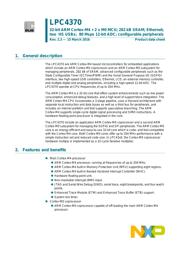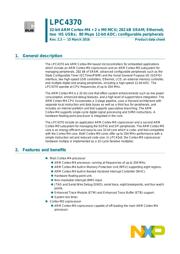Part Datasheet Search > Microcontrollers > LPC4370 Datasheet PDF

Images are for reference
LPC4370 Datasheet PDF
Part Series:
LPC4370 Series
Category:
Microcontrollers
Description:
32Bit ARM Cortex-M4 + 2 x M0 MCU; 282KB SRAM; Ethernet; two HS USBs; 80MSPS 12Bit ADC; configurable peripherals
Updated Time: 2023/01/13 02:10:12 (UTC + 8)
LPC4370 Microcontrollers Datasheet PDF
LPC4370 Datasheet PDF Microcontrollers
LPC4370FET256E - NXP Specifications
TYPE
DESCRIPTION
Mounting Style
Surface Mount
Frequency
204 MHz
Number of Pins
256 Pin
Case/Package
LBGA-256
Number of Positions
256 Position
show more
LPC4370FET256E - NXP Function Overview
●Overview
●The LPC4370 are ARM Cortex-M4 based microcontrollers for embedded applications which include an ARM Cortex-M0 coprocessor and an ARM Cortex-M0 subsystem for managing peripherals, 282 kB of SRAM, advanced configurable peripherals such as the State Configurable Timer (SCT) and the Serial General Purpose I/O (SGPIO) interface, two High-speed USB controllers, Ethernet, LCD, an external memory controller, and multiple digital and analog peripherals including a high-speed 12-bit ADC. The LPC4370 operate at CPU frequencies of up to 204 MHz.
●The ARM Cortex-M4 is a next generation 32-bit core that offers system enhancements such as low power consumption, enhanced debug features, and a high level of support block integration. The ARM Cortex-M4 CPU incorporates a 3-stage pipeline, uses a Harvard architecture with separate local instruction and data buses as well as a third bus for peripherals, and includes an internal prefetch unit that supports speculative branching. The ARM Cortex-M4 supports single-cycle digital signal processing and SIMD instructions. A hardware floating-point processor is integrated in the core.
●The LPC4370 include an application ARM Cortex-M0 coprocessor and a second ARM Cortex-M0 subsystem for managing the SGPIO and SPI peripherals. The ARM Cortex-M0 core is an energy-efficient and easy-to-use 32-bit core which is code- and tool-compatible with the Cortex-M4 core. Both Cortex-M0 cores offer up to 204 MHz performance with a simple instruction set and reduced code size.
●MoreLess
●## Features
● Main Cortex-M4 processor:
● ARM Cortex-M4 processor, running at frequencies of up to 204 MHz
● ARM Cortex-M4 built-in Memory Protection Unit (MPU) supporting eight regions
● ARM Cortex-M4 built-in Nested Vectored Interrupt Controller (NVIC)
● Hardware floating-point unit
● Non-maskable Interrupt (NMI) input
● JTAG and Serial Wire Debug (SWD), serial trace, eight breakpoints, and four watch points
● Enhanced Trace Module (ETM) and Enhanced Trace Buffer (ETB) support
● System tick timer
● Cortex-M0 coprocessor:
● ARM Cortex-M0 coprocessor capable of off-loading the main ARM Cortex-M4 processor
● Running at frequencies of up to 204 MHz
● JTAG and built-in NVIC
● Cortex-M0 subsystem:
● ARM Cortex-M0 processor controlling the SPI and SGPIO peripherals residing on a separate AHB multilayer matrix with direct access to 2 kB + 16 kB of SRAM
● Running at frequencies of up to 204 MHz
● Connected via a core-to-core bridge to the main AHB multilayer matrix and the main ARM Cortex-M4 processor
● On-chip memory:
● 264 kB SRAM for code and data use on the main AHB multilayer matrix plus 18 kB of SRAM on the Cortex-M0 subsystem
● Multiple SRAM blocks with separate bus access. Two SRAM blocks can be powered down individually
● 64 kB ROM containing boot code and on-chip software drivers
● 64-bit + 256 bit general-purpose One-Time Programmable (OTP) memory
● Configurable digital peripherals:
● Serial GPIO (SGPIO) interface
● State Configurable Timer (SCT) subsystem on AHB
● Global Input Multiplexer Array (GIMA) allows to cross-connect multiple inputs and outputs to event driven peripherals like the timers, SCT, and ADC0/1
● Serial interfaces:
● Quad SPI Flash Interface (SPIFI) with four lanes and up to 52 MB per second
● 10/100T Ethernet MAC with RMII and MII interfaces and DMA support for high throughput at low CPU load. Support for IEEE 1588 time stamping/advanced time stamping (IEEE 1588-2008 v2)
● One High-speed USB 2.0 Host/Device/OTG interface with DMA support and on-chip high-speed PHY
● One High-speed USB 2.0 Host/Device interface with DMA support, on-chip full-speed PHY and ULPI interface to external high-speed PHY
● USB interface electrical test software included in ROM USB stack
● One 550 UART with DMA support and full modem interface
● Three 550 USARTs with DMA and synchronous mode support and a smart card interface conforming to ISO7816 specification. One USART with IrDA interface
● Two C_CAN 2.0B controllers with one channel each. Use of C_CAN controller excludes operation of all other peripherals connected to the same bus bridge
● Two SSP controllers with FIFO and multi-protocol support. Both SSPs with DMA support
● One SPI controller
● One Fast-mode Plus I²C-bus interface with monitor mode and open-drain I/O pins conforming to the full I²C-bus specification. Supports data rates of up to 1 Mbit/s
● One standard I²C-bus interface with monitor mode and with standard I/O pins
● Two I²S interfaces, each with DMA support and with one input and one output
● Digital peripherals:
● External Memory Controller (EMC) supporting external SRAM, ROM, NOR flash, and SDRAM devices
● LCD controller with DMA support and a programmable display resolution of up to 1024 H x 768 V. Supports monochrome and color STN panels and TFT color panels; supports 1/2/4/8 bpp Color Look-Up Table (CLUT) and 16/24-bit direct pixel mapping
● Secure Digital Input Output (SD/MMC) card interface
● Eight-channel General-Purpose DMA (GPDMA) controller can access all memories on the AHB and all DMA-capable AHB slaves
● 164 General-Purpose Input/Output (GPIO) pins with configurable pull-up/pull-down resistors and open-drain mode
● GPIO registers are located on the AHB for fast access. GPIO ports have DMA support
● Up to eight GPIO pins can be selected from all GPIO pins as edge and level sensitive interrupt sources
● Two GPIO group interrupt modules enable an interrupt based on a programmable pattern of input states of a group of GPIO pins
● Four general-purpose timer/counters with capture and match capabilities
● One motor control Pulse Width Modulator (PWM) for three-phase motor control
● One Quadrature Encoder Interface (QEI)
● Repetitive Interrupt timer (RI timer)
● Windowed watchdog timer (WWDT)
● Ultra-low power Real-Time Clock (RTC) on separate power domain with 256 bytes of battery powered backup registers
● Alarm timer; can be battery powered
● Analog peripherals:
● One 10-bit DAC with DMA support and a data conversion rate of 400 kSamples/s. LBGA256 package only
● Two 8-channel, 10-bit ADCs (ADC0/1) with DMA support and a data conversion rate of 400 kSamples/s for a total of 16 independent channels. The 10-bit ADCs are only available on the LBGA256 package
● One 6-channel, 12-bit high-speed ADC (ADCHS) with DMA support and a data conversion rate of 80 MSamples/s
● Unique ID for each device
● Clock generation unit:
● Crystal oscillator with an operating range of 1 MHz to 25 MHz
● 12 MHz Internal RC (IRC) oscillator trimmed to 1 % accuracy over temperature and voltage
● Ultra-low power Real-Time Clock (RTC) crystal oscillator
● Three PLLs allow CPU operation up to the maximum CPU rate without the need for a high-frequency crystal. The second PLL is dedicated to the High-speed USB, the third PLL can be used as audio PLL
● Clock output
● Power:
● Single 3.3 V (2.2 V to 3.6 V) power supply with on-chip DC-to-DC converter for the core supply and the RTC power domain
● RTC power domain can be powered separately by a 3 V battery supply
● Four reduced power modes: Sleep, Deep-sleep, Power-down, and Deep power-down
● Processor wake-up from Sleep mode via wake-up interrupts from various peripherals
● Wake-up from Deep-sleep, Power-down, and Deep power-down modes via external interrupts and interrupts generated by battery powered blocks in the RTC power domain
● Brownout detect with four separate thresholds for interrupt and forced reset
● Available as LBGA256 and TFBGA100 packages
●## Target Applications
● Motor control
● Power management
● White goods
● RFID readers
● Embedded audio applications
● Industrial automation
● e-metering
●## Features
show more
Part Datasheet PDF Search
Example: STM32F103
Loading...
72,405,303 Parts Datasheet PDF, Update more than 5,000 PDF files ervery day.


